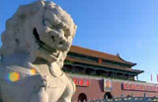Chicken-blood jade dealers feather nests
Updated: 2015-04-24 08:16
By Huo Yan/Wang Xiaodong
|
|||||||||||
 |
|
A worker uses a machine to cut rock containing pieces of chicken-blood jade.[HUO YAN/CHINA DAILY] |
A relative newcomer
Compared with other famous Chinese jade that has been excavated for thousands of years, such as those from Hotan in the Xinjiang Uygur autonomous region, and Anyang in Henan province, chicken-blood jade from Gui-lin is a relative newcomer. It wasn't until 2006, when the Gemological Association of China conducted tests and officially recognized the stone, that it began to gain popularity outside its home area.
Previously, the jade had been regarded as a type of chicken-blood stone, which has been excavated in parts of China, including Sanmen, for hundreds of years. However, Guilin's chicken-blood jade has a number of unusual characteristics, such as a high degree of hardness and great resistance to corrosive chemicals such as acids, that distinguish it from the inferior chicken-blood stone, according to Wu Guozhong, a former vice-president of the GAC.
Storeowner Zhou said the price of the stone began to soar in 2011, turning what had been seen as an inferior material into a valuable commodity. "Before 2006 it was disposed of as waste material," he said.
Li Sisheng, chairman of the Guilin Guanshitang Chicken-blood Jade Museum in Longsheng county, said: "In 2007, the price of the raw jade material was about 1,600 yuan ($258) a metric ton, but it's now 50,000 a ton."
She Qiuming, who owns a store in Guilin, said she has a piece of rare chicken-blood jade about 4 meters long and weighing 18 tons that was valued at 300 million yuan by gemological experts in February.
During the ninth China-ASEAN Expo held in 2012 in Nanning, the capital of Guangxi, souvenirs made from chicken-blood jade were presented as official gifts to attendees from Southeast Asian countries.
Locally owned stores that sell chicken-blood jade dominate both sides of Sanmen's biggest road. Stones of various shapes and sizes, some as tall as 2 meters, that are expected to produce chicken-blood jade after polishing stand at the doors of most of the shops, attracting the eyes of passers-by.
"At least 30 households in the town have become (yuan) millionaires in the past few years through the chicken-blood jade business," Zhou said.
During a visit to the fledgling Guilin Guanshitang Blood-jade Museum, the city's first museum dedicated to the material, in July, Guilin's Party chief Zhao Leqin pledged support for the development of jade-related arts businesses, arguing that they would further enhance Guilin's status as a destination for tourists from around the world.
"We've collected a number of sculptures made from the very best chicken-blood jade," Li Sisheng, chairman of the museum and an avid jade collector, said. "We will open the museum to the public in May, when the building work has finished."
Construction of the facility, which will occupy an area of about 6,700 square meters, started in 2012 with support from the local government, Li said. By the end of January, the museum had become home to 260 sculptures made from the local jade, and more than 200 pieces of stone that contain the rare mineral, he said. Some of the exhibits came from a mining site that Li's company-Zhaohui Stone Material Co, a miner in Sanmen that has been operating since 2010-has excavated, while others were purchased from individual collectors, he said.
"Although our company excavates nearly 10,000 tons of minerals every year, we only get about 30 tons of top-quality jade," he said. "We will not sell a single piece, though-we will collect them in the museum so everyone can enjoy their beauty."
A government-supported industrial zone has been established in Sanmen, and is expected to facilitate related industries, including manufacturing, sales and art exhibitions. The township will also hold regular cultural festivals to display and promote the local culture.
While the skyrocketing price of chicken-blood jade is attracting a large number of investors, they should be wary of the risks, according to Li. "Excavating the jade is sometimes like gambling. Although Sanmen has abundant resources, it's not easy to find materials that are rich in chicken-blood jade because it's usually hidden in rocks that appear to be no different from ordinary rocks," he said. "Sometimes we've excavated hundreds of tons of stone without finding even the smallest piece of jade."
Related Stories
Bengbu's jade industry on rocky road 2015-02-11 07:55
Future of jade market shaky in Bengbu 2015-01-08 07:13
National gem and jade trade center planned in Panyu 2014-12-01 16:30
Man finds his fortune in mending 2015-02-12 14:36
Yunnan: Ruili First City to trade Kyat in China 2015-04-09 19:37
Trade mission seeks opportunity 2015-04-07 10:48
Today's Top News
China and Russia to start search for Soviet soldiers' remains
Kim likely to visit Russia in May for war victory ceremony
Specialists discuss hot topics in China-EEC relations
Europe gaining importance in China's foreign investment
EU leaders to restore rescue operations after migrant boat disaster
EU, Cuba to hold political dialogue meeting in June
Britain celebrates Queen Elizabeth II 's 89th birthday
Cuban FM visits France over relations
Hot Topics
Lunar probe , China growth forecasts, Emission rules get tougher, China seen through 'colored lens', International board,
Editor's Picks

|

|

|

|

|

|






